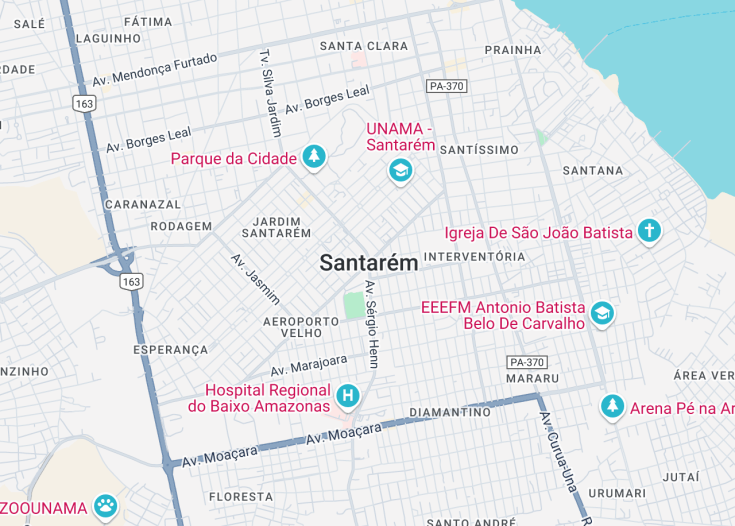Santarém, nestled at the confluence of the Tapajós and Amazon Rivers, offers a unique blend of breathtaking natural beauty and rich cultural heritage. This vibrant city is renowned for its pristine white sand beaches, especially Alter do Chão, often referred to as the “Caribbean of the Amazon”.
Visitors can explore the lush rainforest, experience the bustling river markets, and discover the area’s indigenous history. Santarém serves as a gateway to the Amazon, providing an authentic glimpse into the diverse ecosystems and the traditional lifestyles of the region’s native communities.
When visiting Santarém, be sure to plan a river cruise to witness the enchanting ‘Meeting of the Waters’, where the Amazon and Tapajós rivers converge distinctly.
For an unforgettable experience, schedule your visit during the Festival do Sairé, which features vibrant cultural parades, traditional dances, and craft markets.
Top things to do & see in Santarém
Select the following sights and activities to discover best tickets and tours available in Santarém.
Santarém: Gateway to the Amazon
| Country | Brazil |
| Time in Santarém | GMT-3 |
| Language spoken | Portuguese |
| Population | 299,419 (IBGE 2020) |
| Currency | Brazilian Real (R$ / BRL) |
| Airports |
|
Located in the heart of the Brazilian Amazon, Santarém is a city of vibrant history and richness. Situated at the confluence of the Tapajós and Amazon rivers, the city serves as a vital hub for both riverine and jungle tours. Despite its modest urban infrastructure, Santarém draws visitors due to its unique position close to several protected areas of the Amazon rainforest.
Historically, the city was founded by Portuguese colonists in the 17th century and has been a crucial player in the rubber boom during the early 20th century. Today, Santarém boasts a mix of indigenous and colonial culture, which is reflected in its architecture, cuisine, and local festivals like Çairé — a vibrant blend of indigenous and religious festivities.
Where is Santarém?
Santarém is strategically located in northeastern Brazil, bridging the rapidly flowing Tapajós River and the mighty Amazon.
Distances:
| Route | Distance by car | Time by car |
|---|---|---|
| Belém to Santarém | 821 km | Approx. 18 hours |
| Manaus to Santarém | 1,500 km (by river) | Approx. 24-36 hours by boat |
What is Santarém famous for?
Santarém is renowned for its breathtaking river beaches, particularly Alter do Chão, often dubbed the ‘Caribbean of the Amazon’. Its rich culture, history, and proximity to diverse ecosystems also make it a unique tourist destination.
History
Before 1661: Indigenous Roots
The region around Santarém was originally inhabited by indigenous groups, predominantly by the Tapajós people, who were known for their intricate ceramics and vibrant culture. This pre-colonial era was marked by a rich biodiversity, which sustained these indigenous communities for centuries.
1661 – Establishment as a Jesuit Mission
In the year 1661, Jesuit priests established a mission at the site of present-day Santarém. This point marks the beginning of recorded history for the area, transitioning from indigenous stronghold to a budding colonial settlement under Portuguese influence. The mission served as a focal point for the spread of Christianity and the integration of local populations into the colonial economy.
18th – 19th Century: Development and Conflict
Throughout the 18th and 19th centuries, Santarém evolved from a mission into a strategic military outpost. Its location along the Amazon River made it an essential point for the transport of goods and a buffer zone against incursions from other colonial powers, such as Spain. During this period, the town saw conflicts between settlers and indigenous groups, as well as between colonial powers.
20th Century: Economic Shifts and Modernization
The 20th century brought significant changes to Santarém, with the development of rubber and later nuts being central to its economy. The city modernized with the construction of roads and the establishment of air links, which connected it more closely with the rest of Brazil. During this time, Santarém received waves of migrants from the Northeast of Brazil, diversifying its cultural fabric.
21st Century: A Contemporary Hub
In the 21st century, Santarém has become a notable destination within Brazil, known for its unique blend of Amazonian and river cultures. The city has embraced tourism while preserving its historical heritage and natural environment, effectively balancing modernity with tradition.
Visit Santarém
What to see and do in Santarém
Exploring Santarém offers a blend of natural beauty and cultural richness. Key attractions include:
- The Meeting of the Waters, where the Amazon and Tapajós rivers converge.
- Historic Centro, showcasing colonial architecture and the Museu Dica Frazão, with intricate handicrafts.
- Pristine beaches like Alter do Chão, often called the ‘Caribbean of the Amazon.’
- Forest hiking and wildlife watching in the Tapajós National Forest.
These activities highlight Santarém’s unique geographical and cultural landscape.
Annual Festivals and Celebrations
One cannot miss the vibrant festivals in Santarém, which celebrate its indigenous and riverine heritage:
- Sairé Festival (September): A blend of religious ceremonies and indigenous cultural expressions.
- Festival do Çairé (Also September): Features traditional music, dance, and folklore.
- Amazon Film Festival (November): Showcases regional, national, and international films.
These events provide deep insights into the local culture and are best experienced live.
Best time to visit Santarém
The ideal time to visit Santarém is during the dry season from June to November. This period offers sunny days ideal for river excursions and beach activities, making it a prime time for tourists seeking the full Amazon experience.
Is Santarém worth visiting?
Santarém is undoubtedly worth visiting for those intrigued by the Amazon’s mystique and biodiversity. It offers a rare glimpse into the confluence of riverine and jungle ecosystems, coupled with a rich cultural tapestry that reflects its indigenous and colonial past.
Whether it’s exploring river beaches, hiking through dense forest, or enjoying local festivals, Santarém presents a unique blend of attractions that enthrall any visitor.









